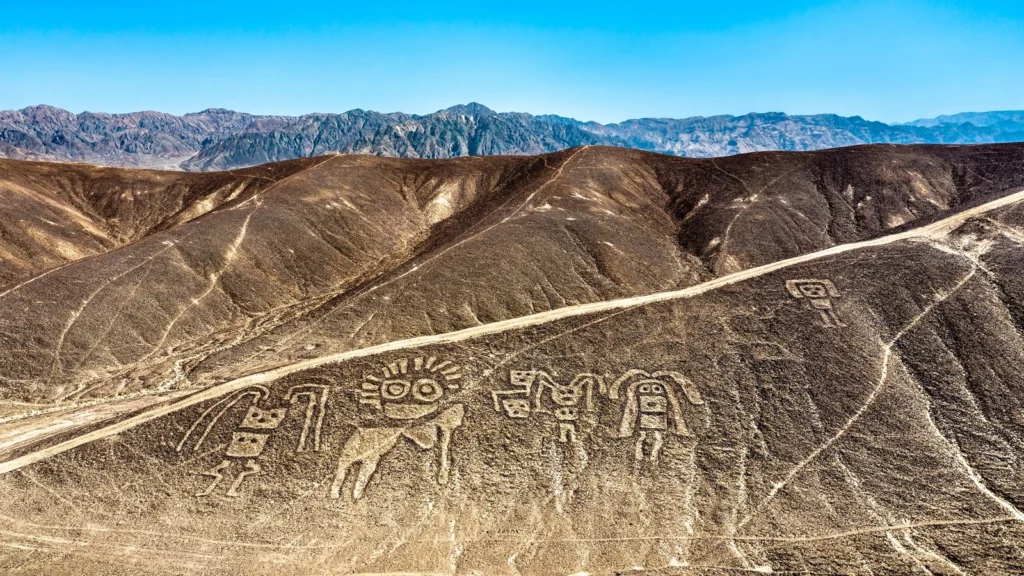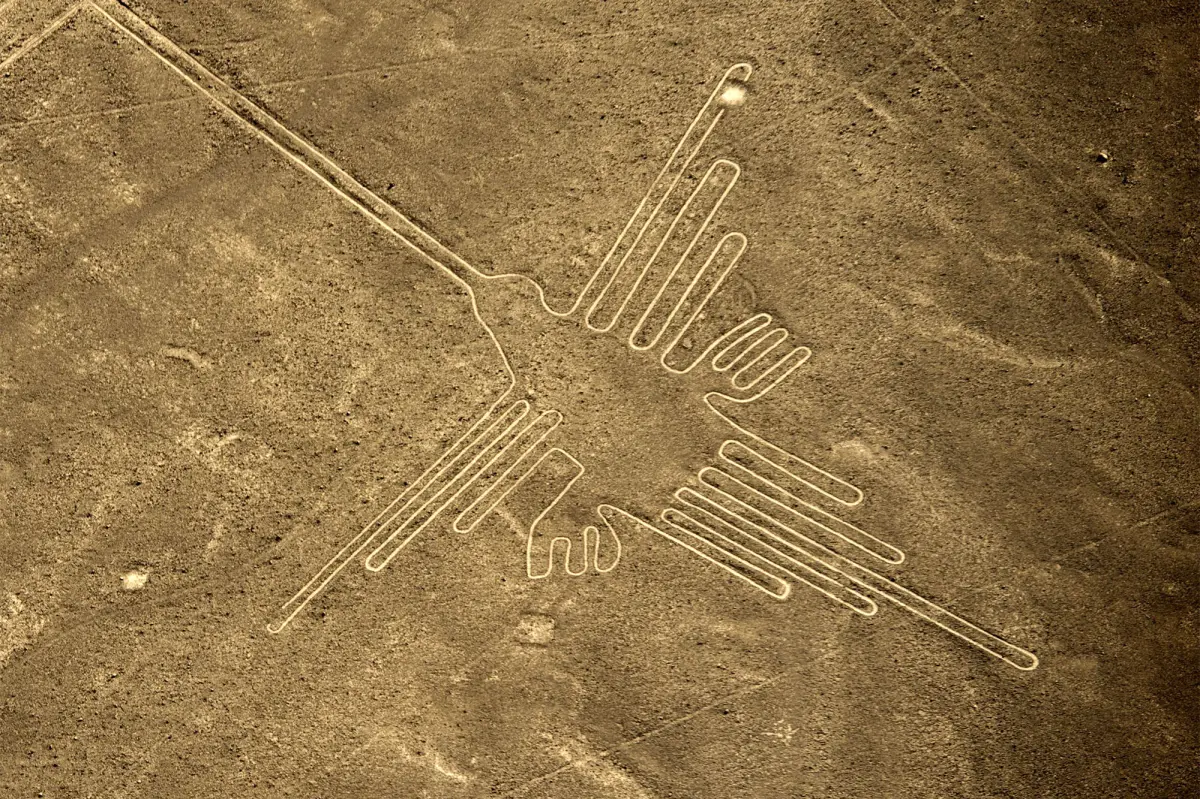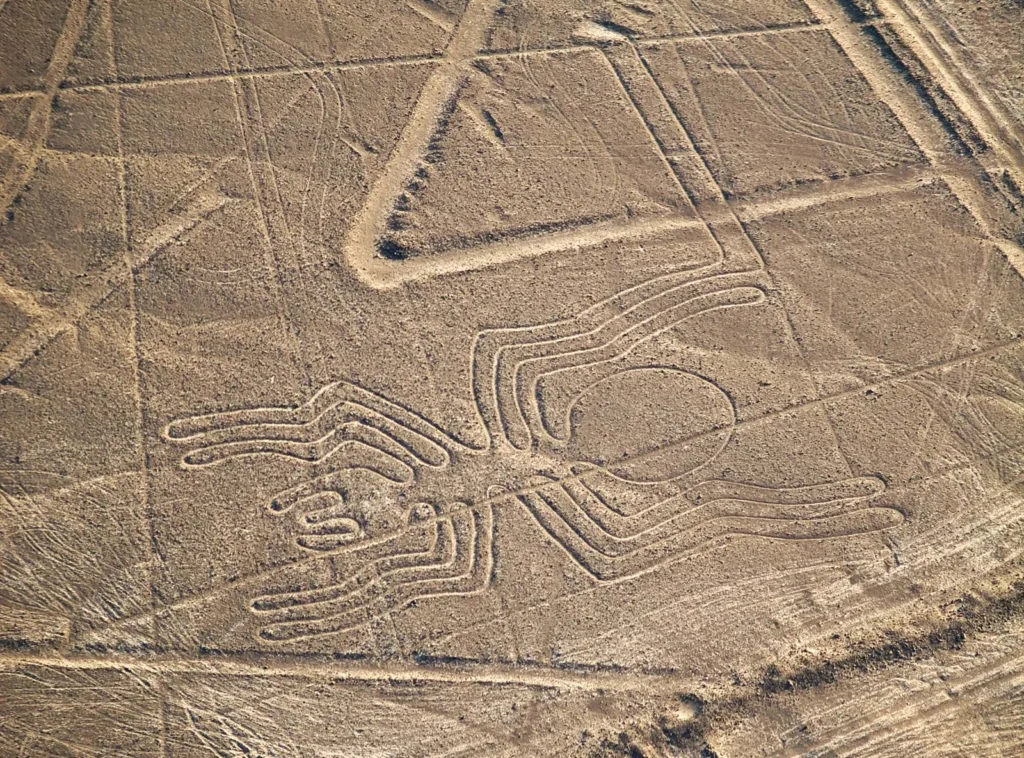Etched into the desert plains of southern Peru, scores of mysterious geoglyphs each tell a story hidden for two millennia. Dating back to prehistoric times, they have attracted archaeologists, historians and explorers over the years. The Nazca Lines, made of thousands of geometric shapes, 70 animals and 900 straight lines, cover an area of 500 square kilometers on the arid plateau, the region the driest in the world. Their sheer size is what really makes them baffling with some 1,200 feet long.
What gives these incredible creations their purpose and meaning still remains a mystery, boggling the minds of experts, along with anyone else who theorizing about their existence. For some they may simply have been paths for ceremonial processions, while for others they were rectangles forming an ancient astronomical calendar. However, the precision, or more to the point the execution of the designs leaves no doubt these were not just doodles in the sand. In 1994, the Nazca lines were to be inscribed on the UNESCO World Heritage List because of their archaeological significance.
History and discovery of the Nazca Lines
Contents
- 1 History and discovery of the Nazca Lines
- 2 Significance and theories surrounding the Nazca Lines
- 3 The different types of Nazca Line figures
- 4 How were the Nazca Lines created?
- 5 Preservation and protection of the Nazca Lines
- 6 Visiting the Nazca Lines: Tips and guidelines
- 7
- 8 The controversy surrounding the Nazca Lines
- 9 Other ancient wonders in the Nazca region
- 10 The enduring mystery of the Nazca Lines
- 11 Author
The backstory of the Nazca Lines is just as fascinating as the lines left on the desert! Spanish conquistadors first laid eyes on these ancient wonders during the 16th century when they were just exploring the region. But scientific investigation of the Nazca Lines really didn’t take off until the early 20th century. The first person who studied them in the 1920s (and was probably the first one to bring them to the attention of us, outsiders) was Toribio Mejia Xesspe, Peruvian archaeologist.

Significance and theories surrounding the Nazca Lines
For many decades the Nazca lines have intrigued scholars and researchers alike, with many theoretical ideas trying to explain what their purpose was. One explanation is that the lines were designed as routes used in ceremonial processions and and rituals. The idea gains some credence because of the sheer scale and complexity of the figures, including animals such as hummingbirds, monkeys, and perhaps even spiders. A widely accepted theory is that the lines were a sort of giant astronomical calendar, predicted astronomical events, mapped constellations and planetary bodies.
The different types of Nazca Line figures
The Nazca Lines consist of over 800 straight lines, 300 geometric figures, and 70 animal and plant formations. These include lines, triangles, and spirals. The patterns vary considerably; some are isolated, familiar shapes such as parabolas or dots; while others are interconnected, combining to make up large geometric clouds formed by the desert floor itself. Some of the best known of the Nazca Lines are the animal figures. The spiders, monkey, hummingbirds and condors are a few examples of the animal-like figures that have seized the attention of the entire world.
How were the Nazca Lines created?
It is unclear of the process used to create the massive designs created at the yowestogel. The dominant hypothesis, however, is that the Nazca people removed the so-called desert varnish—reddish-brown iron oxide pebbles that contribute to the desert surface—and instead revealed the iron-poor, white earth just underneath. These pebbles were how they shaped these archetypal lines and figures. The detailed designs speak for themselves about its contemporary technological knowledge with respect to geometry and metering.
Preservation and protection of the Nazca Lines
Preserving the Nazca Lines is of utmost importance to ensure their longevity for future generations. The delicate nature of the desert floor makes it susceptible to erosion and damage. Efforts have been made to protect the lines by limiting access to certain areas and implementing strict guidelines for visitors. UNESCO and the Peruvian government have been working together to safeguard this cultural treasure, employing measures such as aerial surveillance and educational programs to raise awareness about the importance of preserving the Nazca Lines.
Visiting the Nazca Lines: Tips and guidelines
If you’re planning a visit to the Nazca Lines, there are a few important tips and guidelines to keep in mind. Firstly, it’s advisable to book a guided tour to fully appreciate the historical and cultural significance of the site. These tours often provide expert commentary and insights into the various theories surrounding the lines. It’s also crucial to respect the rules and regulations set forth by the authorities to protect the fragile desert floor. Lastly, be prepared for the arid desert conditions by wearing sunscreen, a hat, and comfortable clothing.
The controversy surrounding the Nazca Lines
Despite their historical and cultural significance, the Nazca Lines have not been without controversy. Some argue that the influx of tourism and the increasing number of flights over the lines pose a threat to their preservation. Additionally, there have been instances of vandalism, with individuals leaving their mark on the lines. Striking a balance between promoting tourism and ensuring the long-term protection of the Nazca Lines remains an ongoing challenge.
Other ancient wonders in the Nazca region
While the Nazca Lines are undoubtedly the most famous attraction in the area, the region surrounding Nazca is also home to other ancient wonders. The Chauchilla Cemetery, for instance, offers a glimpse into the burial practices of the Nazca people. Here, mummified remains and artifacts have been preserved, providing valuable insights into the culture and customs of this ancient civilization. The Cahuachi Pyramids, a ceremonial center believed to have been a religious and administrative hub, are another notable site worth exploring.
The enduring mystery of the Nazca Lines
The Nazca Lines continue to captivate and perplex researchers and visitors alike. Their sheer size, intricate designs, and enigmatic purpose have stood the test of time, leaving us to marvel at the ingenuity and imagination of the ancient Nazca people. While many theories attempt to explain their meaning, the true purpose of the lines remains elusive. As we explore the history, significance, and awe-inspiring beauty of the Nazca Lines, we are reminded of the enduring mystery that surrounds these ancient wonders. The Nazca Lines are not merely etchings in the desert, but a testament to the rich cultural heritage of humanity. Let us embrace the mystery and continue to unravel the secrets hidden within the lines.
Also read: Nasi Tutug Oncom: From Traditional Kitchens to Modern Tables






